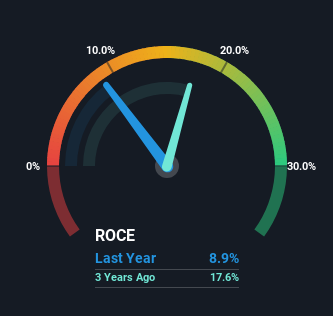
Did you know there are some financial metrics that can provide clues of a potential multi-bagger? Typically, we'll want to notice a trend of growing return on capital employed (ROCE) and alongside that, an expanding base of capital employed. Put simply, these types of businesses are compounding machines, meaning they are continually reinvesting their earnings at ever-higher rates of return. Having said that, from a first glance at Onde (WSE:OND) we aren't jumping out of our chairs at how returns are trending, but let's have a deeper look.
Understanding Return On Capital Employed (ROCE)
For those that aren't sure what ROCE is, it measures the amount of pre-tax profits a company can generate from the capital employed in its business. To calculate this metric for Onde, this is the formula:
Return on Capital Employed = Earnings Before Interest and Tax (EBIT) ÷ (Total Assets - Current Liabilities)
0.089 = zł31m ÷ (zł680m - zł328m) (Based on the trailing twelve months to September 2022).
Thus, Onde has an ROCE of 8.9%. Ultimately, that's a low return and it under-performs the Construction industry average of 14%.
See our latest analysis for Onde

Historical performance is a great place to start when researching a stock so above you can see the gauge for Onde's ROCE against it's prior returns. If you're interested in investigating Onde's past further, check out this free graph of past earnings, revenue and cash flow.
SWOT Analysis for Onde
- Debt is well covered by earnings.
- Earnings declined over the past year.
- OND's financial characteristics indicate limited near-term opportunities for shareholders.
- Lack of analyst coverage makes it difficult to determine OND's earnings prospects.
- Debt is not well covered by operating cash flow.
So How Is Onde's ROCE Trending?
When we looked at the ROCE trend at Onde, we didn't gain much confidence. Over the last three years, returns on capital have decreased to 8.9% from 18% three years ago. On the other hand, the company has been employing more capital without a corresponding improvement in sales in the last year, which could suggest these investments are longer term plays. It's worth keeping an eye on the company's earnings from here on to see if these investments do end up contributing to the bottom line.
On a side note, Onde's current liabilities are still rather high at 48% of total assets. This effectively means that suppliers (or short-term creditors) are funding a large portion of the business, so just be aware that this can introduce some elements of risk. While it's not necessarily a bad thing, it can be beneficial if this ratio is lower.
The Bottom Line On Onde's ROCE
To conclude, we've found that Onde is reinvesting in the business, but returns have been falling. Although the market must be expecting these trends to improve because the stock has gained 12% over the last year. But if the trajectory of these underlying trends continue, we think the likelihood of it being a multi-bagger from here isn't high.
One more thing to note, we've identified 1 warning sign with Onde and understanding it should be part of your investment process.
While Onde may not currently earn the highest returns, we've compiled a list of companies that currently earn more than 25% return on equity. Check out this free list here.
New: AI Stock Screener & Alerts
Our new AI Stock Screener scans the market every day to uncover opportunities.
• Dividend Powerhouses (3%+ Yield)
• Undervalued Small Caps with Insider Buying
• High growth Tech and AI Companies
Or build your own from over 50 metrics.
Have feedback on this article? Concerned about the content? Get in touch with us directly. Alternatively, email editorial-team (at) simplywallst.com.
This article by Simply Wall St is general in nature. We provide commentary based on historical data and analyst forecasts only using an unbiased methodology and our articles are not intended to be financial advice. It does not constitute a recommendation to buy or sell any stock, and does not take account of your objectives, or your financial situation. We aim to bring you long-term focused analysis driven by fundamental data. Note that our analysis may not factor in the latest price-sensitive company announcements or qualitative material. Simply Wall St has no position in any stocks mentioned.
About WSE:OND
Onde
Engages in the designing and construction solutions for the renewable energy sector in Poland and internationally.
Excellent balance sheet slight.
Similar Companies
Market Insights
Community Narratives



